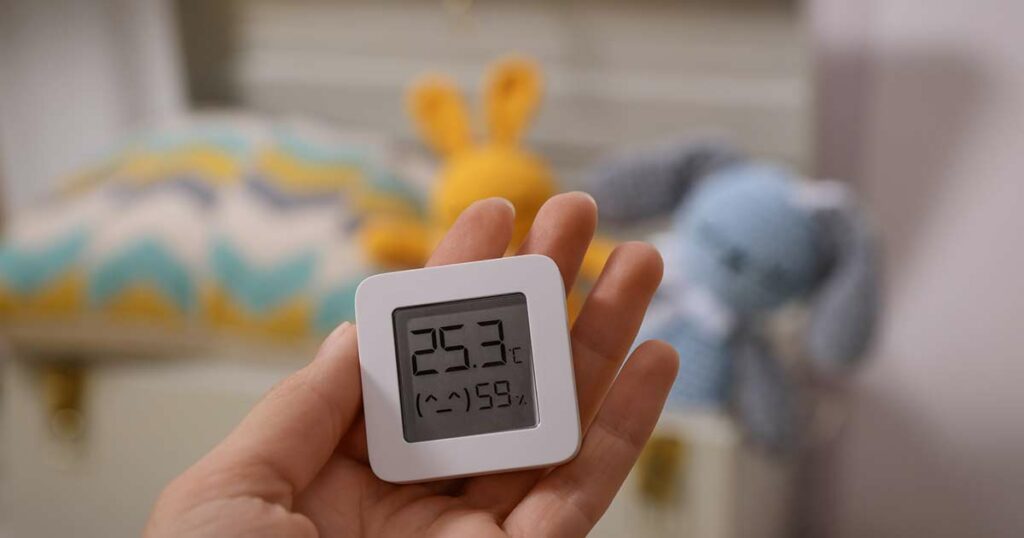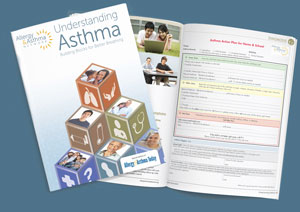Asthma Symptoms & Triggers
- Home
- |
- What is Asthma?
- |
- Asthma Symptoms & Triggers
When you understand the signs of asthma and what can trigger asthma symptoms, you take a step toward controlling your disease. You take a step toward improving your daily life and overall well-being.
What are common asthma symptoms in infants, children, teens and adults? What is in your environment that may be an asthma trigger? Take a closer look at asthma symptoms and triggers and be sure to include them in your Asthma Action Plan.

Common asthma symptoms include:
- Coughing: An asthma cough is often worse at night or early morning. Sometimes it’s your only symptom. It can be dry or mucus filled.
- Wheezing: This is a whistling sound or squeaky sound especially when you breathe out. Sometimes wheezing can be heard easily; other times you need a stethoscope. A stethoscope is a medical device used to listen to breath sounds.
- Chest tightness: This can feel like something is squeezing or sitting on your chest.
- Shortness of breath: You may feel breathless, like you can’t catch your breath or breathe deeply enough. You may feel as though you are out of shape and constantly tired.
Asthma symptoms in adults
Asthma affects people of all ages including adults. Some may experience adult-onset asthma symptoms, or symptoms that first occur in adulthood. Asthma in adults can vary in severity and intensity. In addition to common symptoms of coughing, wheezing, chest tightness and shortness of breath, adults may experience:
- Fatigue: asthma can cause fatigue or a general feeling of low energy. This can be due to the extra effort required to breathe.
- Difficulty sleeping: asthma symptoms can worsen at night, leading to disrupted sleep. If asthma wakes you up more than twice a month, this is a sign of uncontrolled asthma.
- Increased mucus production: asthma can cause excess mucus, which may be coughed up or felt as phlegm in the throat.
- Exercise-induced symptoms: some adults with asthma may have worsened symptoms during or after physical activity. Exercise-induced asthma (EIA), also called exercise-induced bronchoconstriction (EIB), is a condition where the airways narrow during or shortly after exercise.

Asthma symptoms in teens
Asthma can have a significant impact on teenagers. It can affect their physical, emotional, and social well-being. It can be particularly disruptive during activities like sports, exercise, or even simply walking between classes. These limitations may lead to frustration and reduced participation in activities.
In addition to common symptoms, teens may also experience tiredness or fatigue, excess mucus production, difficulty sleeping and EIB.
Parents, caregivers and doctors should monitor teens’ mental health. Managing asthma, in addition to schoolwork and social stressors, can feel overwhelming. Hospital visits due to asthma and the need to carry inhalers can make teenagers feel different from their peers. This could lead to feelings of embarrassment, self-consciousness, exclusion, isolation and frustration.

Asthma symptoms in babies and children
Most people with asthma are first diagnosed with the condition in the first 10 years of life. In infants and toddlers and preschoolers, it can be hard for parents and sometimes doctors to diagnose a child’s asthma. This is because their bronchial tubes are small and narrow. Illnesses, allergens and irritants can irritate their airways, making them even smaller.
Symptoms of asthma in babies and children can vary. It’s hard to monitor symptoms in infants because they are unable to communicate how they are feeling or what they are experiencing.
In addition to common symptoms, babies and children with asthma may display other related symptoms:
- Fast, shallow breathing (an increased respiratory rate)
- Fussiness
- Fatigue or decreased activity
- Bellies move more when inhaling or exhaling
- Nostrils open up when breathing
- Symptoms worse at night
- Problems eating
- Recurrent respiratory infections
- Blue tint to skin and fingernails – a sign of an asthma attack
- Environmental allergies and/or food allergies
Allergy, asthma and other respiratory conditions often coexist. Children with eczema, environmental allergies and food allergies may be at higher risk of developing asthma.

Asthma symptoms in pregnancy
Asthma is a common chronic disease in pregnancy. Some may experience worse asthma symptoms, some may experience improved symptoms, and some will have no change at all. Pregnant women previously diagnosed with severe asthma are more likely to have worse asthma symptoms.
Healthy breathing is vital to a healthy pregnancy and healthy baby. Your unborn baby depends on you for oxygen. Asthma symptoms during pregnancy could mean you and your baby may not be getting enough oxygen. Poorly controlled asthma puts you at increased risk for complications. This can endanger the health of both the mother and unborn baby.
Symptoms that indicate your asthma is in the danger zone and you should get immediate medical help or call 9-1-1:
- your breathing does not improve in response to quick-relief medication;
- you notice reduced fetal movements;
- you have difficulty breathing and your asthma medicines do not help;
- headaches;
- vomiting;
- vaginal bleeding.

Download "Questions to Ask your Doctor about Asthma" ➤
Are the symptoms different between mild, moderate and severe asthma?
Symptoms of mild, moderate and severe asthma can differ. Asthma is very individualized, so there may be some overlap. Here are symptoms for each:
Mild Asthma
- Symptoms occur a couple times a week but less than once a day.
- Symptoms may awaken you at night 1-2 times a month.
- Lung function is usually normal between episodes but may be slightly reduced.
- Episodes may last a few days and may affect daily activities.
- Symptoms are usually controlled with quick-relief inhalers but may require additional long-term control medications.
Moderate Asthma
- Symptoms occur daily.
- Symptoms may awaken you at night more than once a week but not every night.
- Lung function is reduced, and airflow limitation may be present.
- Episodes may last several days, occur frequently, and may interfere with daily activities.
- Symptoms often require regular use of long-term control medications, in addition to quick-relief inhalers.
Severe Asthma
- Symptoms occur throughout the day.
- Symptoms may awaken you at night frequently.
- Lung function is significantly reduced, with frequent airflow limitations.
- Episodes can last for days or weeks and severely limit daily activities.
- Symptoms often require high-dose, long-term control medications and frequent use of quick-relief inhalers.

Does humidity affect asthma?
Humidity in the air is a common asthma trigger. It contains moisture that makes the air heavier and denser. It can also cause the air to be stagnant. This makes it harder for people with asthma to breathe efficiently. Humidity combined with hot weather can activate sensory nerve fibers in the airways, causing them to narrow. This can lead to asthma symptoms. Humidity also creates an environment where air pollutants and allergens such as pollen and mold linger in the air — and potentially lead to a severe attack.

Talking About the Weather
What's the spring allergy outlook where you live? Will sudden temperature changes trigger an asthma flare? Weather can play a key role in allergy and asthma symptoms, as well as flu transmission. Allergy & Asthma Network partnered with Weather Trends International to provide forecasting and analysis for people with asthma and allergies. It compiles information about an area's temperature, anticipated pollen forecast, flu prevalence, and more in determining its forecast.

What are common asthma attack symptoms?
If your symptoms suddenly worsen, you may be having an asthma attack. Any of these signs indicate the need for immediate medical treatment.
- Symptoms don’t respond when you take a quick-relief medication.
- It feels like you can’t catch a good deep breath or can’t get the air out of your chest.
- You can’t talk except in short phrases.
- You have a cough that will not stop, or you simply feel too exhausted to breathe.
- Your shoulders tense and raise closer to your ears than normal.
- It’s easier to breathe while sitting and leaning forward than when lying down.
- Your fingernails turn blue, or your lips become bluish or gray in color.
- You start sweating even though your skin feels clammy and cold.
- The skin around your chest, ribs and collarbones sinks in with each breath and you’re using stomach muscles to help you breathe.
- You experience swelling of your throat, tongue or limbs.
Using a peak flow meter can help you identify the early warning signs of an asthma attack. A peak flow meter is a handheld device that measures Peak Expiratory Flow Rate (PEFR). This is the maximum speed you can force air out of your lung’s large airways. PEFR can show how well your lungs are working.
Follow your Asthma Action Plan when symptoms occur or for asthma flare-ups. Call 9-1-1 for severe episodes.

Get a Free Copy of Our "Understanding Asthma" Guide ➤
Questions & Answers (Q&A) on Asthma Symptoms
Here are some of the most common questions we’re asked about asthma symptoms. If you have any questions you would like to see answered here, please email the editor.
What's the difference between asthma symptoms and COPD?
Asthma is usually diagnosed early in a person’s life. Symptoms include coughing, wheezing, chest tightness and shortness of breath. Patients often have allergies that can trigger symptoms. They may also have a family history of asthma and allergies.
COPD tends to occur in people after the age of 40. It involves lung diseases that develop over time, primarily emphysema and chronic bronchitis. Symptoms are like asthma but also involve increased mucus or phlegm and more respiratory tract infections. COPD is often the result of long-term, heavy cigarette smoking. The disease tends to get worse over time.
A person can have both asthma and COPD at the same time. This is called Asthma-COPD Overlap (ACO). Treatment is similar – short-acting and long-acting bronchodilator inhalers and inhaled corticosteroids. But COPD may also involve long-acting muscarinic antagonists (LAMAs), also called anticholinergics.
Why are my asthma symptoms worse at night?
Many people with asthma experience symptoms at night. This is called nocturnal asthma, or sometimes just nighttime asthma. Studies show lungs work best during the day, with peak lung function at about 4 p.m. Twelve hours later – around 4 a.m. – lung function is at its lowest. For most people, the fluctuation is less than 10 percent. However, people with asthma can have up to a 50 percent difference between daytime and nighttime lung function.
Other factors that can impact sleep in people with asthma include:
- Medication usage. The effects of a short-acting bronchodilator used at bedtime can wear off after 4-6 hours. This can result in waking up coughing, wheezing or short of breath because another dose is needed.
- Allergen exposure. Exposure to allergens during the day can set off a chain reaction in the immune system that produces allergic reactions and asthma symptoms hours later. Allergens such as dust mites or pet dander in the bedroom can also cause symptoms.
- Postnasal drip and congestion from allergies. This can cause multiple nighttime “micro-arousals.” These awakenings are so brief that the sleeper may not even remember them, but they affect alertness the following day.
- Gastroesophageal reflux disease (GERD). Also called acid reflux or just reflux, GERD is a backwash of stomach acid into the esophagus. Reflux is more common when a person is lying down, so people with asthma may wake up with a sudden, intense cough. This can worsen asthma symptoms at night. Studies reveal that as many as 75% of adults with asthma also have reflux.
- Sleep apnea. People with asthma are at increased risk for sleep apnea. This is a sleep disorder that causes repeat pauses in breathing throughout the night. It can set off or worsen asthma.
If you experience disrupted sleep at night two or more times per night, it may mean your asthma is getting worse. Talk with your doctor or an asthma specialist about your symptoms and whether you need to adjust your medications or Asthma Action Plan.
The best way to prevent coughing and wheezing at night is to have good asthma control. Identify your triggers and work with your doctor to take steps to limit exposure or remove them. Don’t take any medications or drink caffeine that stimulate you and keep you awake. Create a healthy sleeping environment in your bedroom.
What are exercise-induced asthma symptoms?
Some people experience asthma symptoms during or after exercise or physical activity. This is exercise-induced asthma (EIA), also called exercise-induced bronchospasm (EIB). It occurs when airways narrow during vigorous exercise or physical activity. This leads to coughing, wheezing and shortness of breath. EIA can occur in people diagnosed with asthma and those who are not diagnosed with asthma.
It’s believed that dry air is a primary culprit because it can dry out the airways. Exposure to pollen and/or air pollution when exercising outdoors can also trigger symptoms. Doctors recommend people with EIA pre-treat their airways with a quick-relief albuterol inhaler prior to exercise. They should also warm up beforehand and stay hydrated before, during and after physical activity.
What if I have asthma symptoms but not asthma?
Some people may experience symptoms of asthma, but without an asthma diagnosis. If you experience asthma-like symptoms or asthma episodes, it’s important to consult a healthcare professional for a proper evaluation and testing. Perhaps you don’t have asthma, but if your symptoms persist, you may have a different lung disease, such as bronchiectasis, COPD or primary immunodeficiency disease.
Consider your environment. Are allergens such as pollen, mold, dust mites or animal dander triggering your cough? Are there chemicals or strong odors in your environment? Is there secondhand smoke? Identify possible allergens and irritants and do your best to avoid them. Reduce exposure to these triggers by keeping your living space clean and well-ventilated with fresh air. Monitor your symptoms by tracking their patterns – when and how often they occur and how severe. Keep a symptom diary. Do symptoms arise when you go outside? Are you at risk for respiratory infections. This information can be useful when discussing your symptoms with a health professional.
Can I have unusual asthma symptoms?
While asthma is commonly associated with wheezing, coughing and shortness of breath, other unusual symptoms can occur. These may include:
- Rapid breathing: Some people with asthma may experience rapid breathing during an asthma attack, rather than the more typical wheezing or gasping for air.
- Fatigue: Asthma can sometimes lead to exhaustion, particularly during or after an asthma attack. The effort of breathing, especially if it becomes difficult, can be physically and mentally draining.
- Difficulty speaking: In severe cases, asthma can affect the ability to speak normally or speak in full phrases due to the limited airflow and increased effort required for breathing. Strong emotions such as laughter can also trigger symptoms or make asthma worse.
- Anxiety or panic: An asthma attack can trigger feelings of anxiety, panic or fear in some people.
- Chronic cough: While coughing is a common asthma symptom, some people may experience a persistent, dry cough as a symptom of asthma. This cough may not produce any phlegm or mucus.
How do I know if I have severe asthma?
It is estimated that 5-10% of people with asthma have severe asthma. The number may be higher because studies show many people with asthma report their symptoms are uncontrolled.
From a medical standpoint, severe asthma is the diagnosis when…
-
asthma symptoms are not well-controlled by high-dose inhaled corticosteroids (also called anti-inflammatory controller medications);
-
the patient experiences two or more asthma attacks in a 12-month span requiring oral corticosteroids (pills that treat severe acute asthma symptoms).
Here’s what to watch for to indicate your asthma is severe:
-
an increased use of quick-relief albuterol inhalers (two times a week or more);
-
symptoms persist even though you’re taking medication;
-
frequent coughing, especially at night;
-
difficulty sleeping or sleep disturbances due to asthma symptoms.
A wide range of treatments are available. Talk with your doctor or a specialist in respiratory care.
Is there such a thing as silent asthma attack symptoms?
Silent asthma describes a severe form of asthma that can occur even though there are no apparent symptoms. A person experiencing a silent asthma attack may not cough or wheeze. Instead they may suddenly struggle to breathe normally. They may have difficulty speaking or experience chest tightness. They may feel very dizzy, tired or distressed, and even pass out.
Silent asthma is a serious and life-threatening condition because flare-up are not easily recognizable. Talk with your doctor if you’re concerned you have this condition.
See Related Pages
- Asthma Attack
- Asthma Camp
- Alternative and Natural Asthma Treatments
- Asthma Symptoms & Triggers
- Asthma Medication and Treatment
- Asthma Diagnosis and Testing
- Lifestyle Changes to Manage Asthma
- Asthma Management and Control
- Asthma Patient Assistance
- Asthma Action Plan
- What is Severe Asthma?
- Asthma and Exercise
- Asthma in Babies and Children
- Asthma and Pregnancy
- Vaping and Smoking with Asthma
- Asthma Dictionary
- Asthma Statistics
- Asthma Webinars
- Ask the Allergist About Asthma
Reviewed by:
Bradley Chipps, MD, FACAAI, is a board-certified allergist and pediatric pulmonologist with Capital Allergy and Respiratory Disease Center in Sacramento, California. He earned his medical degree from University of Texas Medical Branch in Galveston in 1972. He is Past President of the American College of Allergy, Asthma and Immunology (ACAAI).
